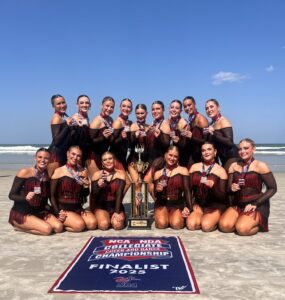Athletics in need of additional funding
KC Smurthwaite
editor-in-chief
[email protected]
The score box for the men’s and women’s Jan. 6 show an easy win for both Golden Eagle basketball teams. But for those who witnessed the victories over Colorado Northwestern Community College that weekend, know that these aren’t the CNCC teams of past.
This archived article was written by: KC Smurthwaite
KC Smurthwaite
editor-in-chief
[email protected]
The score box for the men’s and women’s Jan. 6 show an easy win for both Golden Eagle basketball teams. But for those who witnessed the victories over Colorado Northwestern Community College that weekend, know that these aren’t the CNCC teams of past.
The USU Eastern starters were not pulled early in the second half like they have been in past games against the Spartans. For a good portion of both games, Colorado looked like they were going to pull out a W, or at least keep it close. With 16 minutes left in the men’s game, the Golden Eagles were holding onto a one-point win.
For most of this past decade, the Spartans have produced the door mat athletic teams of the conference. They can be compared with the 2008 Detroit Lions (0-16), 2003 Detroit Tigers (48-116), or the 1992-1993 Dallas Mavericks (10-72). One can argue that these are professional teams, but what about the collegiate level?
New Jersey Institute of Technology (NJIT) didn’t win a college basketball game from Feb. 19, 2007, until Jan. 21, 2009. The Highlanders lost 51-straight games. The current football team for Lock Haven University has lost 42-consecutive games as a Division-Two school.
Streaks eventually end and athletic programs turn around. Sometimes it takes a great hire, and generally takes a few years to build. To turn around athletic programs it takes cold, hard cash or a drastic change. CNCC is starting that process.
That journey started last year when Colorado Northwestern’s administration and athletic director made a commitment to the athletic’s program. It was a large commitment: an extra $250,000 was added to the athletic program.
That money in the athletic’s program is starting to produce, even in year one. The women’s basketball team in Rangely, Colo., is one win away from 10. That magical number of 10 represents the combined number of victories the Lady Spartan basketball team has had the previous two seasons. As this article is being written, that same Lady Spartan basketball team has a better record than powerhouse Salt Lake Community College.
The CNCC men’s basketball team shows signs of life for a team that garnered their first conference victory in five years during the 2009-2010 season. This season’s team has five wins, and only needs two to tie last year’s win total. The Spartans have four sophomores on the roster in which only two sophomores started Jan. 6’s match-up against USU Eastern.
The CNCC men’s baseball team has a new head coach who is taking the program in a better direction. He is a native of California and is already making that talent-rich state a recruiting priority.
Around USU Eastern’s campus people are worried about low enrollment numbers, cutting student fees and new changes to student services. The parent college in Logan wants higher student fee’s because the lack of cash flow and low enrollment. Now you are asking, is what does this have to do with CNCC?
CNCC has figured out the answers to our questions. They are, well were, in the same boat as us, low enrollment, making changes, etc.
CNCC knows the way to boost enrollment and bring in more money is through athletics. It has been proven and colleges are starting to catch on.
Adams State College (ASC) and Colorado Mesa University (CMU) have taken similar steps in recent years. ASC has added five-enrollment-based teams between 2009 and 2010, while CMU brought on four new programs since 2005.
Both Adams State and Colorado Mesa have reported an increase in enrollment in the years that followed; CMU grew by 14.8 percent and ASC touting a jump of 9 percent this past fall. Other additions, such as online graduate programs, have also helped boost those numbers.
Western State College of Colorado has bought into the idea as well. According to Matt Smith, a reporter for the school “they ( Western State ) followed a model that has been touted for its success at many of WSC’s peer institutions, the addition of these enrollment based athletic teams could bring in as many as 50-additional students-athletes over the year. Enrollment based means that revenues generated from student athletes more than compensate for the cost of the programs.
Athletic Director Dave Paur has been on the bandwagon for years now. His simple comments about the situation is, “ for every student-athlete at the school, he or she will bring another two students.” Not only does it help the school to field athletic teams, but by having a successful athletic program leads to bigger enrollment numbers. With bigger enrollment number, they bring in more money.
Recent studies supported the idea that having successful collegiate athletic teams boost enrollment, no matter the size of the school. The Sports Journal found a 6.59 percent increase in undergraduate applicants for admission in the year following having a football player finish among the top-five vote recipients for the Heisman Trophy, which is the National Player of the Year award. Similarly, Georgetown University had a 45-percent increase in admissions applicants in the mid-1980s over a three year period in the wake of three Final Four appearances in the men’s basketball with star player Patrick Ewing. Northwestern University realized a 21 percent increase in applicants in 1995 a year after winning the Big Ten Conference football championship and Gonzaga University saw an increase of 59 percent in admission applicants from 1997 to 2000 following three years of unprecedented men’s basketball success.
These same ideas that work at bigger schools are being applied at every level. In 2007, Elyse Ashburn, director of communications at University of Maryland in Baltimore County found a correlation between enrollment numbers at junior colleges, and the number of athletics at the college. Her findings were published as “ To Increase Enrollment, Community Colleges Add More Sports.”
Still not convinced?
Students would support higher student fees if they were given to build athletic programs. If they were set high enough, football would return to Carbon County. No, I am not talking about Carbon High, we are talking USU Eastern football.
How is the opening statement of this paragraph supported? Look at our parent college Utah State University. Its very OWN students voted to pay an extra $130 to bring each students annual athletic fees to $243. The results? Just look at their college football team who made its first football bowl game since 1997. That same football team even competed with nationally ranked teams. The excitement is back in Logan, ticket sales are on the rise, and the free advertisement of Utah State Football on ESPN is always a plus.
USA Today reported that Radford University, a D1 school in Virginia relies on student fees to help support ever-expanding athletics budgets. Many schools, including Radford, do not itemize where those fees go for those who pay the tuition bills. USA Today found in an ongoing examination of college athletics finances that the amounts going to athletics are soaring, and account for as much as 23 percent of the required annual bill for in-state students. It is also interesting to note that enrollment increases have been steady at Radford, in fact the enrollment jumped 42 percent from where it was in 2009.
Whether the bill is footed by the school or students (most student scholarships pay part or all of student fee’s), it’s time for USU Eastern to answer back. Colorado made their move, and now sit $200,000 ahead of us in an athletic budget. Colorado is also building something through their athletic dreams.
Ideas are floating around for student activity passes that would boost athletics at USU Eastern. Brigham Young University has an “all-sport pass,” where the student pays a flat fee every semester to get into games for free, or use the campus athletic center. Is it time that happens here?
Will we see more student-athletes working at the BDAC to help pay for athletic scholarships? Or will students be charged to attend sporting events? Questions remain, but some are finding answers. If nothing happens USU Eastern, they may fall into the trap that CNCC remained in for years. The Spartans solved it. They may problems, but are on the right track.




